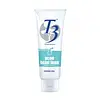What's inside
What's inside
 Key Ingredients
Key Ingredients

 Benefits
Benefits

 Concerns
Concerns

 Ingredients Side-by-side
Ingredients Side-by-side

Water
Skin ConditioningGlycerin
HumectantSodium Cocoyl Glycinate
CleansingLauramidopropyl Betaine
CleansingDisodium Cocoyl Glutamate
CleansingBetaine
HumectantHydroxypropyl Starch Phosphate
Niacinamide
SmoothingCitric Acid
BufferingPhenoxyethanol
PreservativeAllantoin
Skin ConditioningParfum
MaskingDisodium EDTA
Triethylene Glycol
MaskingPanthenol
Skin ConditioningTocopheryl Acetate
AntioxidantButylene Glycol
HumectantGlycyrrhiza Glabra Root Extract
BleachingWater, Glycerin, Sodium Cocoyl Glycinate, Lauramidopropyl Betaine, Disodium Cocoyl Glutamate, Betaine, Hydroxypropyl Starch Phosphate, Niacinamide, Citric Acid, Phenoxyethanol, Allantoin, Parfum, Disodium EDTA, Triethylene Glycol, Panthenol, Tocopheryl Acetate, Butylene Glycol, Glycyrrhiza Glabra Root Extract
Water
Skin ConditioningCocamidopropyl Hydroxysultaine
CleansingDisodium Cocoyl Glutamate
CleansingSodium Lauroamphoacetate
CleansingPEG-120 Methyl Glucose Dioleate
EmulsifyingCitric Acid
BufferingStyrene/Acrylates Copolymer
Phenoxyethanol
PreservativeOlive Oil PEG-7 Esters
EmollientMethylpropanediol
SolventAllantoin
Skin ConditioningMelaleuca Alternifolia Leaf Oil
AntioxidantSodium Chloride
MaskingDisodium EDTA
Ethylhexylglycerin
Skin ConditioningO-Cymen-5-Ol
Antimicrobial4-Terpineol
MaskingEpilobium Angustifolium Flower/Leaf/Stem Extract
Skin ConditioningSalicylic Acid
MaskingSalix Alba Bark Extract
AstringentSodium Metabisulfite
AntioxidantWater, Cocamidopropyl Hydroxysultaine, Disodium Cocoyl Glutamate, Sodium Lauroamphoacetate, PEG-120 Methyl Glucose Dioleate, Citric Acid, Styrene/Acrylates Copolymer, Phenoxyethanol, Olive Oil PEG-7 Esters, Methylpropanediol, Allantoin, Melaleuca Alternifolia Leaf Oil, Sodium Chloride, Disodium EDTA, Ethylhexylglycerin, O-Cymen-5-Ol, 4-Terpineol, Epilobium Angustifolium Flower/Leaf/Stem Extract, Salicylic Acid, Salix Alba Bark Extract, Sodium Metabisulfite
 Reviews
Reviews

Ingredients Explained
These ingredients are found in both products.
Ingredients higher up in an ingredient list are typically present in a larger amount.
Allantoin is a soothing ingredient known for its protective and moisturizingg properties. Because of this, it is often added to products with strong active ingredients.
Studies show higher concentrations of this ingredient can promote wound healing.
Though it can be derived from the comfrey plant, allantoin is produced synthetically for cosmetic products to ensure purity.
Learn more about AllantoinCitric Acid is an alpha hydroxy acid (AHA) naturally found in citrus fruits like oranges, lemons, and limes.
Like other AHAs, citric acid can exfoliate skin by breaking down the bonds that hold dead skin cells together. This helps reveal smoother and brighter skin underneath.
However, this exfoliating effect only happens at high concentrations (20%) which can be hard to find in cosmetic products.
Due to this, citric acid is usually included in small amounts as a pH adjuster. This helps keep products slightly more acidic and compatible with skin's natural pH.
In skincare formulas, citric acid can:
While it can provide some skin benefits, research shows lactic acid and glycolic acid are generally more effective and less irritating exfoliants.
Most citric acid used in skincare today is made by fermenting sugars (usually from molasses). This synthetic version is identical to the natural citrus form but easier to stabilize and use in formulations.
Read more about some other popular AHA's here:
Learn more about Citric AcidWe don't have a description for Disodium Cocoyl Glutamate yet.
Disodium EDTA plays a role in making products more stable by aiding other preservatives.
It is a chelating agent, meaning it neutralizes metal ions that may be found in a product.
Disodium EDTA is a salt of edetic acid and is found to be safe in cosmetic ingredients.
Learn more about Disodium EDTAPhenoxyethanol is a preservative that has germicide, antimicrobial, and aromatic properties. Studies show that phenoxyethanol can prevent microbial growth. By itself, it has a scent that is similar to that of a rose.
It's often used in formulations along with Caprylyl Glycol to preserve the shelf life of products.
Water. It's the most common cosmetic ingredient of all. You'll usually see it at the top of ingredient lists, meaning that it makes up the largest part of the product.
So why is it so popular? Water most often acts as a solvent - this means that it helps dissolve other ingredients into the formulation.
You'll also recognize water as that liquid we all need to stay alive. If you see this, drink a glass of water. Stay hydrated!
Learn more about Water